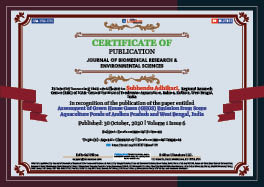Subhendu Adhikari*, Subhas Sarkar, Mandal RN, Ramesh Rathod and Bindu R Pillai
Volume1-Issue6
Dates: Received: 2020-10-20 | Accepted: 2020-10-29 | Published: 2020-10-30
Pages: 241-245
Abstract
The Green House Gas Emission (GHGs) from the carp culture ponds (n = 12) of West Godavari, Krishna, and Guntur districts of Andhra Pradesh and from the ponds (n = 4) of Moyna, East Medinipur district of West Bengal, India was assessed through carbon storage and carbon footprint analysis. The average inputs as Carbon Equivalent (CE) were 14407 ± 2651, and 9231 ± 1007 kg/ha in Andhra Pradesh, and West Bengal, respectively. The average carbon storage were 6216 ± 2291, and 5360 ± 1439 kg/ha, in Andhra Pradesh, and Moyna, West Bengal respectively. The emissions of CO2-e and CH4-e were 1.91 ± 0.42 kg CO2-e/kg fish and 0.122 ± 0.027 kg CH4-e/kg fish, respectively in Andhra Pradesh. The emissions of CO2-e and CH4-e were 0.006 to 2.07 (average 0.72) kg CO2-e /kg fish, and 0.0004 to 0.132 (average 0.046) kg CH4-e /kg fish production, respectively in Moyna, West Bengal.
FullText HTML
FullText PDF
DOI: 10.37871/jbres1149
Certificate of Publication

Copyright
© 2020 Adhikari S, et al. Distributed under Creative Commons CC-BY 4.0
How to cite this article
Adhikari S, Sarkar S, Mandal RN, Rathod R, Pillai BR. Assessment of Green House Gases (GHGS) Emission from Some Aquaculture Ponds of Andhra Pradesh and West Bengal, India. J Biomed Res Environ Sci. 2020 Oct 30; 1(6): 241-245. doi: 10.37871/jbres1149, Article ID: jbres1149
Subject area(s)
University/Institute
References
- FAO. The State of World Fisheries and Aquaculture 2016. Contributing to Food Security and Nutrition for All Rome 200pp. 2016.
- Preto BL, Henares, MNP, Kimpara JM, Valenti WC. Greenhouse emissions from aquaculture. Global aquaculture advocate. 2015 Jan.
- Belettini F, Seiffert WQ, Lapa KR, Vieira FDN, Santo CMDE, Arana LAV. Carbon footprint in commercial cultivation of marine shrimp: A case study in southern Brazil. Revista Brasileira de Zootecnia. 2018 Aug; 47:1-7. doi: 10.1590/rbz4720160353
- Robb DHF, MacLeod M, Hasan MR, Soto D. Greenhouse gas emissions from aquaculture: a life cycle assessment of three Asian Systems. FAO Fisheries and Aquaculture Technical Paper No 609 Rome FAO 110pp. 2017.
- Nijdam D, Rood T, Westhoek H. The price of protein: Review of land use and carbon footprints from life cycle assessments of animal food products and their substitutes. Food Policy. 2012 Dec;37:760-770. doi: 10.1016/j.foodpol.2012.08.002
- Adhikari S, Lal R, Sahu BC. Carbon footprint of aquaculture in eastern India. J Water Climate Change. 2013 Sep; 4(4):410-421 doi: 10.2166/wcc.2013.028
- Lal R, Kimble JM, Follet, RF, Cole CV. The potential of US cropland to sequester carbon and mitigate the greenhouse effect (pp128) Chelsea: Ann Arbor Press. 1998.
- Aqua Climate www.aquaculture.asia/files/climatechange/apn./resource. 1-28.
- Tyedmers PH, Parker R. Fuel consumption and greenhouse gas emissions from global tuna fisheries: A preliminary assessment. ISFF Technical Report 2012-03 International Seafood Sustainability Foundation McLean Virginia USA. 2012 Mar.
- Robb DHF, MacLeod M, Hasan MR, Soto D. Greenhouse gas emissions from aquaculture: a life cycle assessment of three Asian Systems. FAO Fisheries and Aquaculture Technical Paper No 609 Rome FAO 110pp. 2017.
- Salmonfacts (2016). https://salmonfacts.com/salmon-and-environment/how-does-farmed-salmon-affect-co2-emissions/






























































